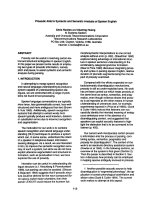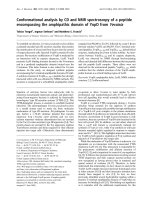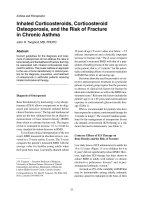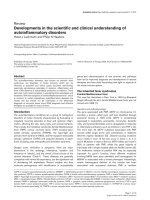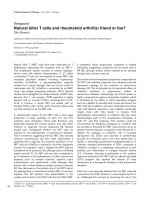Báo cáo y học: "Carbon monoxide affects electrical and contractile activity of rat myocardium" ppt
Bạn đang xem bản rút gọn của tài liệu. Xem và tải ngay bản đầy đủ của tài liệu tại đây (2.04 MB, 7 trang )
RESEARC H Open Access
Carbon monoxide affects electrical and
contractile activity of rat myocardium
Denis V Abramochkin
1*
, Nail N Haertdinov
2
, Maria V Porokhnya
1
, Andrew L Zefirov
3
and Gusel F Sitdikova
2
Abstract
Background: Carbon monoxide (CO) is a toxic gas, which also acts in the organism as a neurotransmitter. It is
generated as a by-product of heme break down catalyzed by heme oxygenase. We have investigate d changes in
electrical and contractile activity of isolated rat atrial and ventricular myocardium preparations under the influence
of CO.
Methods: Standard microelectrode technique was used for intracellular registration of electrical activity in isolated
preparations of atrial and ventricular myocardium. Contractions of atrial myocardial stripes were registered via force
transducer.
Results: CO (10
-4
-10
-3
M) caused prominent decrease of action potential duration (APD) in working atrial
myocardium as well as significant acceleration of sinus rhythm. In addition CO reduced force of contractions and
other parameters of contractile activity. Inhibitor of heme oxygenase zinc protoporphyrin IX exerts opposite effects:
prolongation of action potential, reduction of sinus rhythm rate and enhancement of contractile function.
Therefore, endogenous CO, which may be generated in the heart due to the presence of active heme oxygenase,
is likely to exert the same effects as exogenous CO applied to the perfusing medium. In ventricular myocardium
preparations exogenous CO also induced shortening of action potential, while zinc protoporphyrin IX produced
the opposite effect.
Conclusions: Thus, endogenous or exogenous carbon monoxide may act as an important regulator of electrical
and contractile cardiac activity.
Background
During the last twenty years two toxic gases: carbon
mono xide (CO) and hydrogen sulfi de (H
2
S) were recog-
nized as important regulatory compounds which are
synthesized endogenously in different tissues of the
organism [1]. Along with nitric oxide (NO) CO and H
2
S
represent a class of gaseous transmitters. Cardiovascu lar
effects of NO, CO and H
2
S have been extensively stu-
died. For instance, all three gases act as pot ent vasodila-
tors though NO and CO relax vascular smooth muscle
cells in a few orders of magnitude lower concentrations
than H
2
S [1]. The effect of gaseous mediators on heart
functioning h as received less attention than their effect
on blood vessels. NO donors produce positive inotropic
effect in low concentrations, while higher concentrations
may cause suppression of contractile activity [2]. T hese
compounds also accelerate the sinoatrial node rhythm
and therefore increase the heart rate [1]. Such effects of
NO are mediated by modulation of numerous ionic cur-
rents (I
Ca
,I
Ks
,I
K1
,I
f
and others) via either activation of
soluble guanylyl cyclase with subsequent i ncrease of
intracellular cGMP content and cGMP-independent
mechanisms (S-nitrosylation and direct effects on G
proteins) [3]. In contrast to NO, H
2
S exhibits negative
inotropic activity in all examined concentrations [4], it
also reduces action potential duration (APD) in rat atrial
myocardium [5]. Cardioprotective effe cts of all three
gases against ischemic injury have been described in
several studies [6-8].
Cardiotropic effects of CO have been sparsely investi-
gated and the data are quite controversial. While some
authors report negative inotropic effect of CO [9],
others describe positive inotropy in isolated rat heart
[7]. Nothing is known about po ssible CO-induced
* Correspondence:
1
Department of Human and Animal Physiology, Moscow State University,
Moscow, Russia
Full list of author information is available at the end of the article
Abramochkin et al. Journal of Biomedical Science 2011, 18:40
/>© 2011 Abramochkin et al; licensee BioMed Central Ltd. This is an Open Access article distributed under the terms of the Creative
Commons Attribution License ( which permits unrestricted use, distribution, and
reproduction in any medium, provided the original work is properly cited.
changes of cardiac electrical activity. Nevertheless, inves-
tigation of cardiotropic effects of CO is interesting espe-
cially in the light of cardioprotective action of CO
against ischemia-reperfusion injury shown in several stu-
dies [10, 11]. Therefore, the aim of the present study was
to explore effects of exogenous and endogenous CO on
the electrical and contractile activity of isolated rat myo-
cardium preparation.
Methods
The investigation conformed with the Guide for the
Care and Use of Labora tory Animals published by the
US National Institutes of Health (NIH publication no.
85-23, revised 1996), and the experimental protocol was
approved by the Bioethics Committee of Moscow State
University and the Animal Care and Use Committee of
Kazan State Medical University.
Male Wistar rats ( n = 38) weighing 280-320 g were
decapitated using a guillotine for small animals (Open-
Science, Moscow, Russia), the chest was opened and the
heart rapidly excised a nd immersed in a physiological
solution containing (mM): NaCl, 130.0; KCl, 5.6;
NaH
2
PO
4
,0.6;MgCl
2
,1.1;CaCl
2
,1.8;NaHCO
3
, 20.0
and glucose, 11.0, bubbled with carbogen (95% O
2
-5%
CO
2
), with pH 7.4 ± 0.1.
Intracellular recordings of APs in isolated right atrium
and right ventricular wall of rats
The right atrial preparation, including the auricle, the
crista terminalis, the intercaval region and the sinoatrial
node, was isolated and pinned to the bottom of an
experimental chamber (3 ml) supplied with a physiologi-
cal solution at 10 ml min
-1
(37.5°C). After 2 h of equili-
bration, transmembrane potentials were recorded with
glass microelectrodes (20-30 MΩ) filled with 3 M KCl.
The signal was digitized and analyzed using specific
software (DISoft, Moscow, Russia; Synaptosoft, Decatur,
GA, USA). Spontaneously occurring action potentials
(APs) were recorded from the endocardial surface of the
auricle. In some experiments the sinoatrial node was
removed and the preparation was paced (6 Hz) via silver
teflon-coated electrodes. Stable impalements were main-
tained during the entire period action of the drugs.
Changes in the cycle l ength (CL) and the AP duration
to 50 (APD50) and 90% of repolarization (APD90) were
analyzed. The similar experiments were performed using
isolated right ventricular wall preparation s paced with a
frequency of 6 Hz. APs were also recorded from suben-
docardial layers.
Registration of contractile activity
The stripes of working myocardium o f 4-6 mm length
and 1 mm diameter were excised from the right atrium
preparations and mounted in a special perfusion
chamber (ADInstruments, Sydney, Australia). During
the experiment it was st imulated with a frequency of 0.1
Hz via pair of silver electrodes. The force of contrac-
tions was registered using a mechanotransducer MLT
050/D (ADInstruments, Sydney, Australia). The data
were analyzed with Chart v.5.0 (ADInstruments, Sydney,
Australia) software. The amplitude of contractions was
determined as well as maximal velocity of contraction
(MVC) and relaxation (MVR).
Materials
CO of 99% purity was obtained from NIIKM (Moscow,
Russia). The inhibitor of heme oxygenase (HO) zinc
protoporphyrin-IX (ZnPP) was purchased f rom Sigma
(St Louis, MO, USA).
The stock solution of CO was prepared immediately
before its usage in the experiment by b ubbling of phy-
siological solution with CO. Since the water solubility of
CO is 26.91 mg/l, the concentration of CO in the stock
solution was 0.96 mM [12]. To simplify the presentation
of data we considered it to be 1 mM approximately.
During the experiment the stock solution was used to
prepare physiological solutions with different concentra-
tions of CO which were applied to the experimental
chamber. The stock solution of ZnPP was prepared a s
described by Vreman et al [13]. Experiment s with ZnPP
were carried out at a very low or zero ambient light due
to the photo reactivity of compound [12].
Data analysis
All results in the text, tables and figures are expressed as
means ± S.E.M. for n experiments. All samples were
tested with Kolmogorov-Smirnov normality test. Each
sample differed significantly f rom the normal distribu-
tion (P<0.05 for every sample), so we used non-para-
metric tests for analysis. The effects of CO or ZnPP o n
electrophysiological and mechanical parameters were
compared with respective basal values of these para-
meters by Wilcoxon signed rank test.
Results
Effects of exogenous CO on electrical activity of atrial and
ventricular myocardium
In the initial stage of our study, we investigated the
modulation of APD and CL in spontaneously beating
right atrium preparations during 8 min superfusion by
solution containing CO in different concentrations. Dur-
ing the control conditions, A PD50, APD9 0 and CL were
28.7 ± 3.6 , 58.2 ± 5.3 and 205 ± 18.7 ms, respectively. 5
×10
-5
M CO didn’t alter any of these parameters signif-
icantly. However, the application of higher CO concen-
trations (10
-4
,3×10
-4
,5×10
-4
and 10
-3
M) produc ed a
marked decrease in APD50 and APD90 (Figures 1a, b
and 2a) as well as in CL (Figure 2a). These effects of
Abramochkin et al. Journal of Biomedical Science 2011, 18:40
/>Page 2 of 7
CO were rapidly developing, reaching the maximum
after 5 min of superfusion (Figure 1c). The time course
of development of the effect was similar in all subse-
quent electrophysiological e xperiments with CO, so we
discuss only the maximal values of AP shortening and
reduction of the CL. No significant changes of the rest-
ing membrane potential were registered in any of the
electrophysiological experiments with CO or ZnPP.
It is well known that increase of the beati ng rate per se
leadstothereductionofAPD.Therefore,shorteningof
AP under the action of CO i n spontaneously beating pre-
parations may be due to increase of sinoatrial node rate.
To check this possibility we have performed a series of
experiments with paced atrial preparations. In these
experiments CO reduced APD50 and APD90 as much as
in spontaneously beating preparations (Figure 2b).
In working myocardium of isolated right ventricular wall
CO also induced marked shortening of APs (Figure 2c).
Effects of CO on contractile activity of atrial myocardium
It is generally accepted tha t modulation of electrical
activity may cause substantial changes in force of con-
tractions. Therefore, we studied effects of CO on para-
meters of contractions of isolated right atrial
myocardium stripes. All tested c oncentrations of CO (5
×10
-5
,10
-4
and 3 × 10
-4
M) produced dose-dependent
reduction of three most informative parameters of con-
tractile activity: amplitude of contractions, MVC and
MVR (Figure 1b,d, 3). Thus, exogenous CO suppresses
contractile activity of atrial myocardium in concentra-
tions close to those, which are effective in po int of elec-
trophysiological parameters.
Effects of HO inhibitor ZnPP
We have tried to determine the role of CO endogen-
ously produced in the myocardium by blocking its
synthesis using application of 10
-5
M ZnPP, inhibitor of
Figure 1 Changes in configurat ion of electrical and contract ile activity of atrial myocardium i nduced by CO.Representativeoriginal
traces of (a) action potentials (APs) in spontaneously beating right atrial preparations and (b) contraction curves in paced (0.1 Hz) stripes of
working right atrial myocardium during control conditions and 300 µM CO. Relationship between decrease in (c) AP duration (APD) and (d)
contractile force and the time of CO application-data from separate representative experiments. The black arrow indicates the moment of CO
application.
Abramochkin et al. Journal of Biomedical Science 2011, 18:40
/>Page 3 of 7
HO. This dose was based on previous studies demon-
strating reliable HO activity inhibition at this concentra-
tion [13,14]. ZnPP produced several effects that were all
opposite to the effects of exogenous CO. In sponta-
neously beating atrial preparations it caused increase in
APD50 and APD90 and prolongat ion of CL (Figure 4).
These effects of 10
-5
M Z nPP were significant, but not
as prominent as in the case of e xogenous CO. In paced
atrial (Figure 4b) and ventricular (data not shown) pre-
parations ZnPP also induced prolo ngation of AP repo-
larization. In experiments with registration of
mechanical activity we observed signific ant increase in
amplitude of contractions, MVC and MVR (Figure 5).
Discussion
Inthepresentstudyweprovidethefirsttoourknowl-
edge evidence that CO significantly affects electrical
activity of atrial and ventricular myocardium. We
demonstrate the striking difference between action of
CO in the working myocardium, where it produces
negative effects: shortening of APs and suppression of
contractile activity, and sinoatrial node. Unlike H
2
S[5],
CO accelerates the sinoatrial rhythm. It seems that sig-
nal transduction pathways, which are activated by CO,
may differ in working and sinoatrial cardiomyocytes. For
example, variations in enzymes, which synthesize and
degrade second messengers like cAMP and cGMP, may
be present in these types of cardiac cells. Further inves-
tigation of signal transduction pathways mediating cardi-
otropic effects of CO will help to reveal the mechanisms
of such opposite effects of CO in working and pace-
maker myocardium.
The described negative inotropic effect of CO con-
forms to the findings of Liu et al that demonstrated sup-
pression of rat papillary muscles contractions under 1
mM CO [9]. However, our data are in controversy with
results of Musameh et al showing the positive inotropy
of CO associated with decrease of heart rate in the iso-
lated rat Langendorf-perfused heart prepara tion [7]. The
latter discrepancy might be at least partly due to the dif-
ference in the method of CO application to the perfus-
ing solution. Like Liu et al we used the stock solution
directly saturated with CO, while Musameh et al used
special CO relea sing molecules that may possibly exert
some accessory effects. Mechanisms of both negative
and positive effects of C O need special investigation.
Negative effects on APD and contractile parameters may
be partly explained by suppression of I
CaL
by CO [15],
although this assumption should be tested further.
Unfortunately, blockers of calcium channels drastically
modify electric activity of myocardium. For example,
nifedepine produces extremely large shortening of APs
and slowing of sinu s rhythm if used in concentration
sufficient for full block of I
CaL
. Therefore, effects of
these compounds will mask possible action of CO. So,
we guess that the only way to prove this assumption is
to perform appropriate patch-clamp experiments.
Although exogenous CO causes promine nt changes in
the electrical and mechanical activity o f myocardium, it
Figure 2 Alteration of electrophysiological parameters by CO.
Effects of CO (10
-4
-10
-3
M) on APD and cycle length (CL) in (a)
spontaneously beating atrial preparations, (b) paced atrial
preparations and (c) paced ventricular preparations. The control
values of APD50, APD90 and CL were considered as 100%. The
relative values of these parameters during action of CO are
presented in % of control. * - p < 0.05 versus the respective control
values.
Abramochkin et al. Journal of Biomedical Science 2011, 18:40
/>Page 4 of 7
doesn’t testify to the physiological role of CO as a regu-
lator of cardiac performance. To act as a cardioregulator
CO should be synthesized in the myocardium or in the
close proximity to it, because it is quickly scavenged in
theorganismbyhemoglobinandotherhemeproteins
[16]. CO is generated in the organism as a by-product
of heme breakdown catalyzed by HOs: inducible HO-1
and constitutively expressed HO-2. In normal conditions
expression of HO-1 is detected in heart vascular wall,
but not in cardiomyocytes [16]. However, HO-1 protein
expression may be significantly up-regulated by patholo-
gical stimuli, such as myocardial infarction [ 17], or
hypoxia [18]. HO-2 is expressed in the atrial and vent ri-
cular myocardium [19] as well as in intracardiac n eu-
rons [20]. Thus, heart possesses potential sources of
endogenous CO. Experiments with ZnPP, which inhibits
both isoforms of HO, clearly indicate that inhibition of
end ogenous CO pr oduction leads to significant changes
in electrical and contractile activity of myocardium
which are opposite to the effects of e xogenous CO.
Therefore, endogenous CO seems to be synthesized in
the myocardium in normal conditions and act similarly
to the exogenous CO, although it is still not clear if car-
diac CO is synthesized in the cardiomyocytes by HO-2
or in the coronary vessels by HO-1.
Unfortunately, the present study has several limita-
tions. First, the concentrations of CO sufficient for the
significant alteration of cardiac electrical and mechanical
activity in our experiments are strikingly high. CO is
transported by blood in the form of carbonmonoxy-
hemoglobin A (COHb). Estimated physiological concen-
trations of CO in tissues are rather low, in the nanomo-
lar range if based on normal levels of COHb of 1 to 2%
Figure 3 Alteration of contractile parameters by CO. Effects of CO (5 × 10
-5
-3×10
-4
M) on contractile force, maximal velocity of contraction
(MVC) and maximal velocity of relaxation (MVR) in paced stripes of working atrial myocardium. For all columns p < 0.05 versus the respective
control values.
Figure 4 Changes in electrical activity induced by zinc
protoporphyrin IX. Effects of CO (5 × 10
-5
-3×10
-4
M) on
contractile force, maximal velocity of contraction (MVC) and
maximal velocity of relaxation (MVR) in paced stripes of working
atrial myocardium. The control values of contractile force, MVC and
MVR were considered as 100%. The relative values of these
parameters during action of CO are presented in % of control. * - p
< 0.05 versus the respective control values.
Abramochkin et al. Journal of Biomedical Science 2011, 18:40
/>Page 5 of 7
[21]. However, the correlation between COHb and tis-
sue concentrations of CO is questionable, since CO gen-
erated in living cells would first be scavenged in the
cytosol by heme proteins reaching the bloodstream [16].
In fac t, local concentra tions of CO might be as high as
concentratio ns used in our experiments. The significant
effects of ZnPP validate this assumption, although the
possibility of non-specific ZnPP action can’ tbe
excluded. However, while high concentrations of ZnPP
(10
-4
M) are really able to inhibit guanylyl cyclase [22]
and calcium channels [23], 10
-5
MZnPPisconsidered
as a quite selective HO inhi bitor [22]. Moreover, inhibi-
tion of L-type calcium current leads to shortening of
APs, while ZnPP induces increase in APD.
Conclusions
Thus, we have shown that both exogenous and endo-
genous CO substantial ly alter s electrical and contractile
activity of rat heart by decreasing the APD in working
atrial and ventricul ar myocardium, increasing the sinoa-
trial node beating rate and suppressing the contractile
activity of atrial myocardium.
Acknowledgements
This study was supported by Russian Fund of Basic Research (09-04-00748)
and President Grant for Leading Scientific Schools (NS-5250.2010.4).
Author details
1
Department of Human and Animal Physiology, Moscow State University,
Moscow, Russia.
2
Kazan Federal University, Kazan, Russia.
3
Kazan State
Medical University, Kazan, Russia.
Authors’ contributions
DVA carried out the electrophysiological experiments and prepared the
manuscript. NNH carried out experiments with registration of contractile
activity. MVP participated in the electrophysiological experiments. ALZ
participated in the design of the study. GFS participated in the design of the
study and preparation of the manuscript. All authors read and approved the
final manuscript.
Competing interests
The authors declare that they have no competing interests.
Received: 8 March 2011 Accepted: 15 June 2011
Published: 15 June 2011
References
1. Li L, Hsu A, Moore PK: Actions and interactions of nitric oxide, carbon
monoxide and hydrogen sulfide in the cardiovascular system and
inflammation - a tale of three gases! Pharmacol Ther 2009, 123:386-400.
2. Kojda G, Kottenberg K: Regulation of basal myocardial function by NO.
Cardiovasc Res 1999, 41:514-523.
3. Tamargo J, Caballero R, Gomez R, Delpon E: Cardiac electrophysiological
effects of nitric oxide. Cardiovasc Res 2010, 87:593-600.
4. Geng B, Yang J, Qi Y: H
2
S generated by heart in rat and its effects on
cardiac function. Biochem Biophys Res Commun 2004, 313:362-368.
5. Abramochkin DV, Moiseenko LS, Kuzmin VS: The effect of hydrogen
sulfide on electrical activity of rat atrial myocardium. Bull Exp Biol Med
2009, 147:683-686.
6. Lochner A, Marais E, Genade S, Moolman JA: Nitric oxide: a trigger for
classic preconditioning? Am J Physiol 2000, 279:2752-2765.
7. Musameh MD, Fuller BJ, Mann BE, Green CJ, Motterlini R: Positive inotropic
effects of carbon monoxide-releasing molecules (CO-RMs) in the isolated
perfused rat heart. Br J Pharmacol 2006, 149:1104-1112.
8. Pan TT, Feng ZN, Lee SW, Moore PK, Bian JS: Endogenous hydrogen sulfide
contributes to the cardioprotection by metabolic inhibition preconditioning
in the rat ventricular myocytes. J Mol Cell Cardiol 2006, 40:119-130.
9. Liu H, Song D, Lee SS: Role of heme oxygenase-carbon monoxide
pathway in pathogenesis of cirrhotic cardiomyopathy in the rat. Am J
Physiol Gastrointest Liver Physiol 2001, 280:G68-G74.
10. Clark JE, Naughton P, Shurey S: Cardioprotective actions by a water-
soluble carbon monoxidereleasing molecule. Circ Res 2003, 93:e2-e8.
11. Guo Y, Stein AB, Wu WJ: Administration of a CO-releasing molecule at
the time of reperfusion reduces infarct size in vivo. Am J Physiol Heart
Circ Physiol 2004, 286:H1649-H1653.
12. Zufall F, Leinders-Zufall T: Identification of a long-lasting form of odor
adaptation that depends on the carbon Monoxide/cGMP second-
messenger system. J Neurosci 1997, 17:2703-2712.
13. Vreman HJ, Rodgers PA, Stevenson DK: Zinc protoporphyrin
administration for suppression of increased bilirubin production by
latrogenic hemolysis in rhesus neonates. J Pediatr 1990, 117:292-297.
14. Suematsu M, Goda N, Sano T: Carbon monoxide: an endogenous
modulator of sinusoidal tone in the perfused rat liver. J Clin Invest 1995,
96:2431-2437.
15. Uemura K, Adachi-Akahane S, Shintani-Ishida K, Yoshida K: Carbon
monoxide protects cardiomyogenic cells against ischemic death
through L-type Ca
2+
channel inhibition. Biochem Biophys Res Commun
2005, 334:661-668.
16. Wu L, Wang R: Carbon monoxide: Endogenous production, physiological
functions, and pharmacological applications. Pharmacol Rev 2005,
57:585-630.
17. Lakkisto P, Palojoki E, Backlund T: Expression of heme oxygenase-1 in
response to myocardial infarction in rats. J Mol Cell Cardiol 2002,
34:1357-1365.
Figure 5 Changes in contractile activity induced by zinc
protoporphyrin IX. Effects of ZnPP on contractile activity of
working atrial myocardium: (a) representative traces of contraction
curves during control conditions and 10 µM ZnPP, (b) maximal
effects of ZnPP on contractile force MVC and MVR (n = 5). In part
(b) the control values of contractile force, MVC and MVR were
considered as 100%. The relative values of these parameters during
action of ZnPP are presented in % of control. * - p < 0.05 versus the
respective control values.
Abramochkin et al. Journal of Biomedical Science 2011, 18:40
/>Page 6 of 7
18. Grilli A, De Lutiis MA, Patruno A: Inducible nitric oxide synthase and heme
oxygenase-1 in rat heart: direct effect of chronic exposure to hypoxia.
Ann Clin Lab Sci 2003, 33:208-215.
19. Ewing JF, Raju VS, Maines MD: Induction of heart heme oxygenase-1
(HSP32) by hyperthermia: possible role in stress-mediated elevation of
cyclic 3’:5’-guanosine monophosphate. J Pharmacol Exp Ther 1994,
271:408-414.
20. Hassal CJ, Hoyle CH: Heme oxygenase-2 and nitric oxide synthase in
guinea-pig intracardiac neurons. Neuroreport 1997, 8:1043-1046.
21. Piantadosi CA: Biological chemistry of carbon monoxide. Antioxid Redox
Signal 2002, 4:259-270.
22. Maines MD: The heme oxygenase system: a regulator of second
messenger gases. Annu Rev Pharmacol Toxicol 1997, 37:517-554.
23. Kinobe RT, Dercho RA, Nakatsu K: Inhibitors of the heme oxygenase -
carbon monoxide system: on the doorstep of the clinic? Can J Physiol
Pharmacol 2008, 86:577-599.
doi:10.1186/1423-0127-18-40
Cite this article as: Abramochkin et al.: Carbon monoxide affects
electrical and contractile activity of rat myocardium. Journal of
Biomedical Science 2011 18:40.
Submit your next manuscript to BioMed Central
and take full advantage of:
• Convenient online submission
• Thorough peer review
• No space constraints or color figure charges
• Immediate publication on acceptance
• Inclusion in PubMed, CAS, Scopus and Google Scholar
• Research which is freely available for redistribution
Submit your manuscript at
www.biomedcentral.com/submit
Abramochkin et al. Journal of Biomedical Science 2011, 18:40
/>Page 7 of 7
